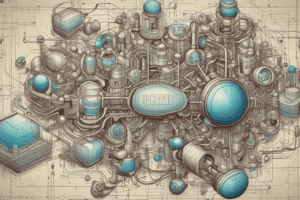Podcast
Questions and Answers
What is the purpose of a communication line in a use case diagram?
What is the purpose of a communication line in a use case diagram?
- To show the relationship between an actor and a use case (correct)
- To indicate the trigger of a use case
- To separate actors from use cases
- To represent the main flow of a use case
What is used to separate actors from use cases in a use case diagram?
What is used to separate actors from use cases in a use case diagram?
- Generalization arrow
- Use case description
- Communication line
- System boundary (correct)
What is included in a use case description?
What is included in a use case description?
- Related requirements, goal, and preconditions (correct)
- Only successful and failed end conditions
- Only primary actors and main flow
- Only trigger and extension
What type of relationship is represented by a dotted arrow labeled with?
What type of relationship is represented by a dotted arrow labeled with?
What is an example of a special case in use case relationships?
What is an example of a special case in use case relationships?
What is the purpose of the 'extends' relationship in use case diagrams?
What is the purpose of the 'extends' relationship in use case diagrams?
What is the notation for the 'uses' relationship in use case diagrams?
What is the notation for the 'uses' relationship in use case diagrams?
What is the term for when one use case is a type of another use case?
What is the term for when one use case is a type of another use case?
What does an actor in a use case represent?
What does an actor in a use case represent?
What is an example of a non-human actor in a use case?
What is an example of a non-human actor in a use case?
What is the notation used to represent an actor in a use case?
What is the notation used to represent an actor in a use case?
What is a use case?
What is a use case?
What is an example of an actor refinement?
What is an example of an actor refinement?
What is the purpose of identifying actors in a use case?
What is the purpose of identifying actors in a use case?
What is the main purpose of a use case in Unified Modeling Language?
What is the main purpose of a use case in Unified Modeling Language?
What is the significance of use cases in a system's design?
What is the significance of use cases in a system's design?
What is the focus of Requirement A.1 in the Weblog CMS example?
What is the focus of Requirement A.1 in the Weblog CMS example?
What is the common aspect between Requirement A.1 and Requirement A.2?
What is the common aspect between Requirement A.1 and Requirement A.2?
What is the primary role of an administrator in the Weblog CMS example?
What is the primary role of an administrator in the Weblog CMS example?
What is the ultimate goal of using use cases in Unified Modeling Language?
What is the ultimate goal of using use cases in Unified Modeling Language?
Flashcards are hidden until you start studying
Study Notes
Use Cases in UML
Use Case Components
- A use case is a case or situation where a system is used to fulfill one or more of a user's requirements.
- A use case captures a piece of functionality that the system provides.
- Actors are things that interact with the system, represented by a stick man or a labeled box, and should be given appropriate names.
- Actors can be actual people or third-party systems, and can also be non-human entities like a system clock.
- Actors can be refined using generalization, where one actor is a general actor of another, meaning the second actor can do everything the first actor can do.
Use Cases
- A use case represents an interaction or case where the system is being used to complete a specific job.
- Use cases are represented by an oval with a name that describes the interaction.
- A good use case should have a clear and concise description.
Communication Lines and System Boundaries
- A communication line connects an actor and a use case to show the actor participating in the use case.
- System boundaries are used to separate actors (external) and use cases (internal), represented by a box, and should be named.
Use Case Descriptions
- Use case descriptions should include:
- Related requirements
- Goal in context
- Preconditions
- Successful end condition
- Failed end condition
- Primary actors
- Secondary actors
- Trigger
- Main flow
- Extension
Use Case Relationships
Inclusion Relationships
- An inclusion relationship represents a use case that can be reused by other use cases.
- Inclusion relationships are represented by a dotted arrow labeled with <>.
Generalization Relationships
- A generalization relationship represents a use case that is a special type of another use case (use case inheritance).
- Generalization relationships are represented by a generalization arrow.
Extension Relationships
- An extension relationship represents a reusable behavior that is optional.
- Extension relationships are represented by a dotted arrow labeled with <>.
Studying That Suits You
Use AI to generate personalized quizzes and flashcards to suit your learning preferences.


